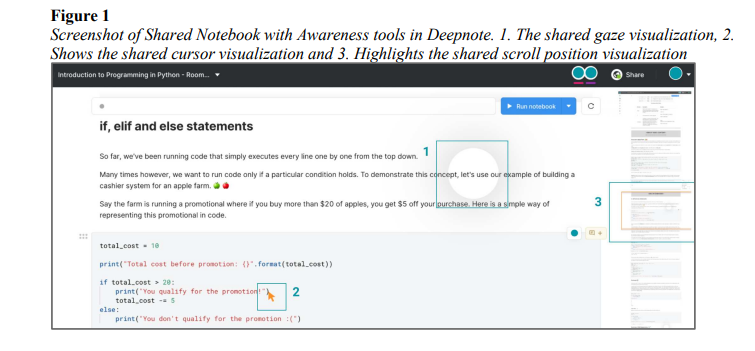Learning to program remotely can be difficult for novices due to a lack of adequate online communication and coding tools. The current paper empirically assessed the impact of real-time collaboration and awareness tools on improving remote programming learning and instruction. Novice programmers were randomly assigned to use either screenshare, a shared online programming notebook (with real-time collaboration), or a shared notebook with awareness tools (shared gaze, mouse and scroll position) with an instructor. Findings revealed that students learned better in the condition where they had access to both real-time collaboration and awareness tools. A discussion of the results reveals the differential benefits of shared gaze and shared cursor for instructors and students and explores the efficacy of sharing web-based eye-tracking data to assist programming instruction. A notable contribution of this work is an open-source chrome extension that enables real-time sharing of awareness tools for online collaborative programming notebooks.

https://repository.isls.org/bitstream/1/8939/1/ICLS2022_1349-1352.pdf
Enhancing Remote Programming Instruction: The Power of Real-Time Collaboration and Gaze Awareness
In a rapidly evolving educational landscape, the rise of remote instruction has created a pressing need for innovative tools that cater to the unique challenges of online learning. Novice programmers, in particular, have faced difficulties in adapting to remote programming courses due to the lack of effective online communication and coding tools. To address this issue, a recent study, conducted by Stephanie Yang from Harvard Graduate School of Education, Allan Jiang from Stanford University, and Bertrand Schneider from Harvard Graduate School of Education, delved into the impact of real-time collaboration and gaze awareness tools on improving remote programming learning and instruction.
The study’s findings shed light on the potential of real-time collaboration and gaze awareness tools to significantly enhance the remote programming learning experience. In this blog post, we’ll take a closer look at the key findings, the practical implications, and how these tools are transforming the world of remote programming instruction.
Challenges in Remote Programming Instruction
The rapid shift towards online education has presented both opportunities and challenges. While remote programming instruction offers flexibility and accessibility, it also introduces communication barriers and cognitive load, especially for novice programmers. Traditional tools like screen sharing, GitHub, and Google Docs have proven inadequate in meeting the needs of students and instructors in this new learning environment. This gap prompted the study to explore the potential of real-time collaboration and awareness tools in addressing these challenges.
The Power of Real-Time Collaboration Tools
One common approach for remote programming instruction has been screen sharing. It enables instructors to see what students are seeing, providing a shared reference point for discussion and insight into the students’ thought processes. However, screen sharing falls short in enabling real-time code input and directing students’ attention effectively. This limitation can overwhelm the cognitive load of novice programmers.
Real-Time Collaboration and Its Impact
The study introduced real-time collaboration tools for programming, allowing both instructors and students to edit the same code synchronously. This approach has shown benefits in the context of pair programming for peer debugging. It allows instructors to collaborate with students in real-time, but its efficacy in coding instruction and learning gains had not been extensively studied.
Conclusion
In a time when remote programming instruction is becoming increasingly common, this study offers a compelling solution to the challenges faced by novice programmers. Real-time collaboration and gaze awareness tools, with the support of webcam-based eye tracking through GazeCloudAPI, have the potential to transform the way we learn and teach programming online. As the educational landscape continues to evolve, innovative tools like these are invaluable in creating engaging and effective learning experiences for students of all levels.
To learn more about the study and the potential of gaze awareness tools in remote programming instruction, please visit GazeRecorder.com. It’s time to unlock the power of real-time collaboration and gaze awareness in your remote programming instruction.